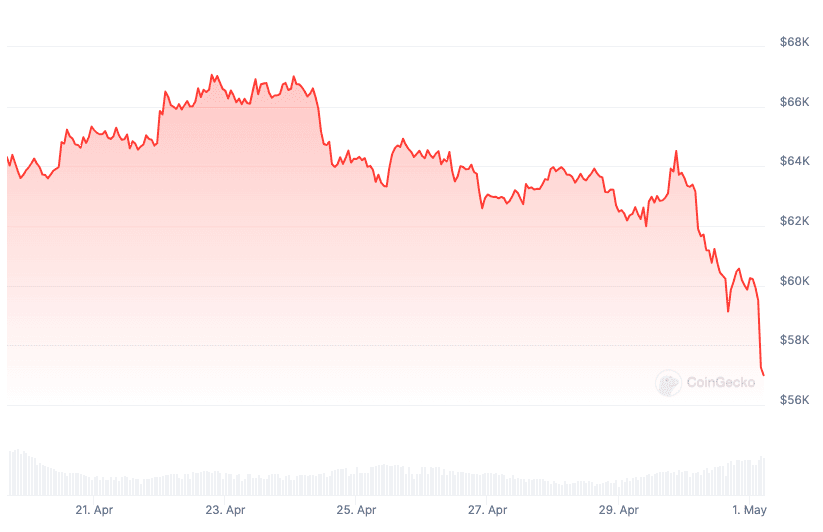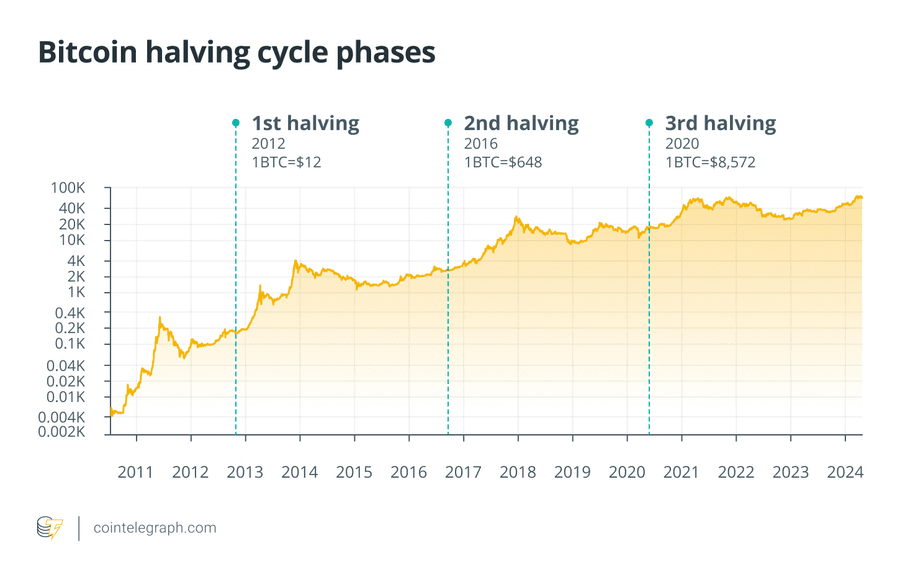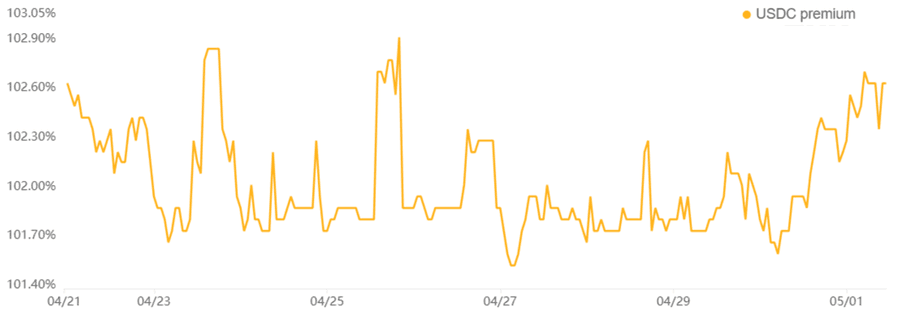Bitcoin has fallen over the past few days, causing concern for those who thought it would skyrocket after its fourth halving. But fear not, for the Federal Reserve’s protocol, Bitcoin miners’ reliability, and the growing demand for stablecoins in China might just be the signs that BTC has hit rock bottom. Or are we in for even more of a slide? Let’s dig in.
Related: Hong Kong’s Crypto ETF Debut: From High Hopes to Modest Beginnings
Halving Expectations and Analyst Insights
The price of Bitcoin has plummeted by 11% since its halving on April 20th, when it was trading around $64,000. Right after the halving, Bitcoin saw a brief rally, surpassing $67,000 on April 22nd. However, it has since been steadily selling off, dropping below $57,000 on May 1st.

The sudden drop in Bitcoin’s price post-halving might have caught those off guard who expected it to follow the pattern of previous halving cycles, where a surge typically occurred roughly a year or so afterward.
However, this ongoing cycle is a far cry from past Bitcoin halvings. One of the standout differences is the extraordinary bull run Bitcoin experienced just before the fourth halving, reaching a new all-time high right before the event. That’s a price trajectory never before seen in Bitcoin’s history.
Some crypto analysts had previously predicted a drop in Bitcoin following the fourth halving. In March 2024, analysts at JPMorgan forecasted that post-event, prices could plummet to $42,000.
According to Markus Thielen, CEO and Chief Analyst at 10x Research, Bitcoin might dip to $52,000. He believes that the recent rally was primarily driven by inflows into Bitcoin exchange-traded funds (ETFs), which sharply slowed down last month.
In the eyes of some analysts, including investment researcher Lyn Alden, there are far more reasons than just the halving and U.S. ETFs for Bitcoin to reach new highs in 2024.
Bitcoin, Federal Reserve, and Miner’s Strength
Bitcoin’s fall from April 30 to May 1st triggered a whopping $172 million worth of long positions liquidation, considering the $28.9 billion open interest in Bitcoin futures before the price drop. So, assuming the bulls were caught off guard would be an oversimplification, to say the least.
But hey, Bitcoin’s not the only one feeling the pinch. Worsening macroeconomic conditions have investors running from risk. The Russell 2000 index, tracking U.S.-based small and mid-cap companies, has fallen 8.2% over the last 30 days, erasing gains of the previous two months.
A clear sign that Bitcoin’s price correction might be bottoming out is the traditional markets, which are basking in the glow of some seriously impressive first-quarter corporate earnings reports. The temporary stock market rebound is diverting investors’ attention from Bitcoin and other risky assets, though traders might be eyeing alternatives if the Fed decides to keep rates higher for an extended period.
Related: Diving into the Dip: MicroStrategy’s Latest Bitcoin Buying
Federal Reserve Rates
Some analysts believe investors are on standby until Jerome Powell, Chair of the Federal Reserve, wraps up his speech after the two-day monetary council meeting on May 1st. While it’s widely expected that the Fed will keep interest rates at 5.25%, there’s considerable skepticism about the U.S. Treasury’s ability to fund the government budget.
After the Fed raised rates in 2023, deficit interest expenses soared by 23% in the first half of 2024 and are projected to keep climbing as long as rates stay up.
Miner Resilience
Bitcoin miners are feeling the heat post-halving on April 20th, slashing their rewards by 50% to 3.125 BTC per block. Ki Young Ju, CEO of CryptoQuant, noted that miner outflow estimates “at the moment” show no signs of capitulation. Ju added that if the Bitcoin price downtrend “stretches for weeks, major miners risk having to liquidate a heap of bitcoins.”
So, another sign that Bitcoin’s slump might be nearing its end is miner resilience. They’re still holding out despite a 57% drop in the hash rate index.
USDC Demand
It might be worth looking into the demand for stablecoins in China, especially USD Coin. The premium for USDC transactions compared to the official USD exchange rate gives insight into retail investor activity, indicating whether they’re entering or exiting cryptocurrency markets.
On May 1st, the USDC premium in China surged to 2.7%, signaling a steady demand for converting Chinese yuan into USDC.
However, despite the potential improvement in market sentiment following the Federal Reserve’s comments and the realization that fears of mining capitulation are unfounded for now, these results show that investment flows are critical to determining Bitcoin price movements, with no certainty that the support level of $56,500 will hold.
Disclaimer: All materials on this site are for informational purposes only. None of the material should be interpreted as investment advice. Please note that despite the nature of much of the material created and hosted on this website, HODL FM is not a financial reference resource and the opinions of authors and other contributors are their own and should not be taken as financial advice. If you require advice of this sort, HODL FM strongly recommends contacting a qualified industry professional.






